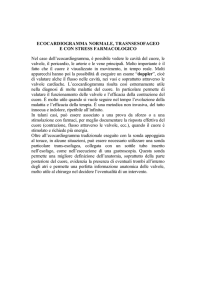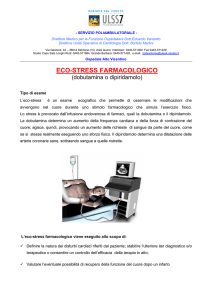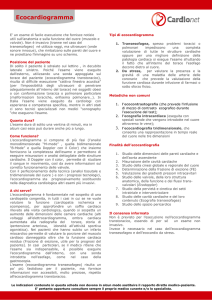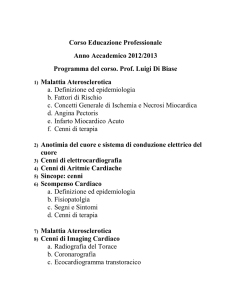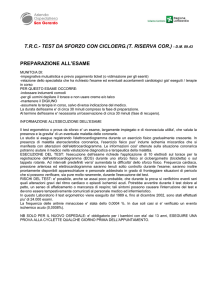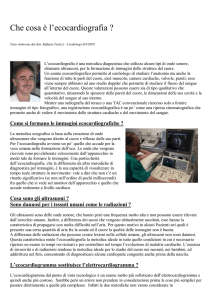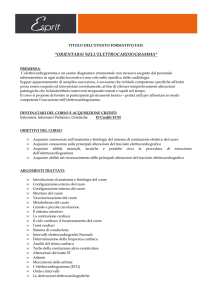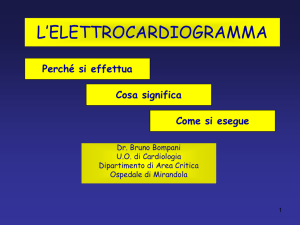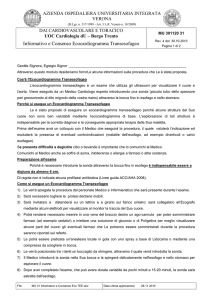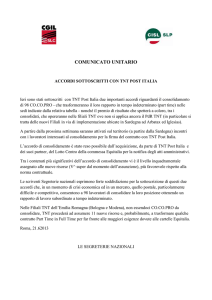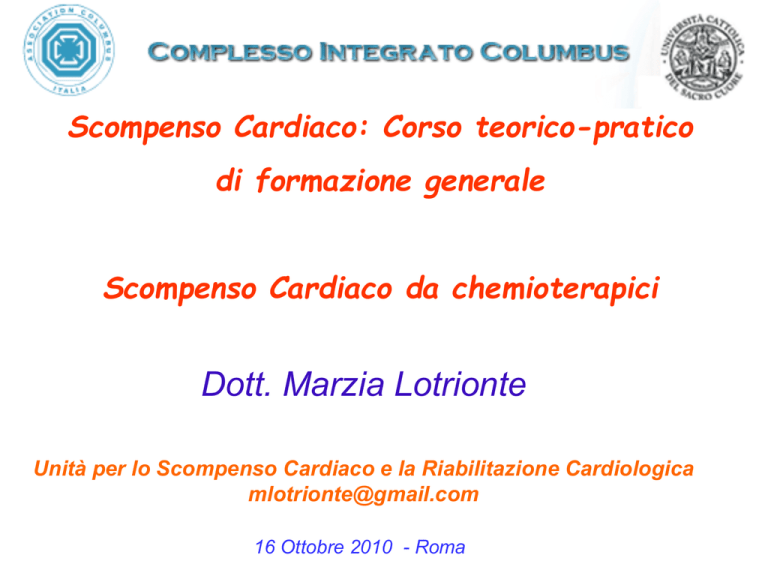
Scompenso Cardiaco: Corso teorico-pratico
di formazione generale
Scompenso Cardiaco da chemioterapici
Dott. Marzia Lotrionte
Unità per lo Scompenso Cardiaco e la Riabilitazione Cardiologica
[email protected]
16 Ottobre 2010 - Roma
DEFINIZIONE
The cardiac review and evaluation committee supervising trastuzumab clinical
trials defined drug-associated cardiotoxicity as one or more of the following:
– 1) cardiomyopathy in terms of a reduction in left ventricular ejection
fraction (LVEF), either global or more severe in the septum;
–
2) symptoms associated with heart failure (HF);
– 3) signs associated with HF, such as S3 gallop, tachycardia, or both;
– 4) reduction in LVEF from baseline that is in the range of less than or
equal to 5% to less than 55% with accompanying signs or symptoms of HF,
or a reduction in LVEF in the range of equal to or greater than 10% to
less than 55%, without accompanying signs or symptoms.
This definition does not include subclinical cardiovascular damage that may occur
early in response to some chemotherapeutic agents.
Thus, to date, an ideal definition is lacking.
INCIDENZA
And the estimated risk of anthracycline-induced
clinical heart failure increased with time to 5.5% at
20 years after the start of anthracycline therapy.
In patients treated with a cumulative anthracycline
dose of 300mg/m² or more the risk was even higher,
almost 10%.
The incidence of anthracycline-induced
asymptomatic cardiac dysfunction has been reported
to be more than 57% at a median of 6.4 years
after treatment.
CLASSIFICAZIONE
ACUTA: subito dopo la prima somministrazione
- età più avanzata
- singola grossa dose
- spesso reversibile
-palpitazioni, dolore toracico, anomalie
ECG, aritmie SV e V, ipotensione, miopericardite
SUBACUTA: da giorni a settimane dopo il trattamento
- rara e spesso asintomatica
- percicardite tossica e/o miocardite
CRONICA: mesi o anni dopo l’ultima somministrazione
a) ad esordio precoce:
- durante o entro 1 aa dal termine tp
- incidenza 1.6-2.1%
- più maligna
- sintomi e segni clinici di SCC
b) ad esordio tardivo:
- decenni per svilupparsi
- incidenza a 6 aa: 65%
- mortalità 30-60%
Lipshultz SE et al. BJH 2005; 131:561-578
- 4 volte più frequente sesso F
- sintomi e segni clinici di SCC
FATTORI DI RISCHIO
- fattori
legati al farmaco: combinazione con altri chemioterapici
sequenza di somministrazione
modalità di somministrazione
dose cumulativa somministrata
- fattori legati al paziente: età > 60 anni
sesso F
RT mediastinica
pregressa chemiotp con Ant
valvulopatie e/o cardiomiopatie pregresse
ipertensione arteriosa
disordini elettrolitici
predisposizione genetica
Kremer LC, et al. Ann Oncol 2002
Fattori di rischio clinico-dipendenti
J Clin Oncol 2005;23:7811-19
Fattori di rischio clinico-dipendenti
J Clin Oncol 2005;23:7811-19
SOPRAVVIVENZA
Maggioni, aprile 1998
Mortalità a 2 aa nei pazienti con
Scompenso Cardiaco nei recenti trials clinici
Cleland JGF Heart August 2008 Vol 94;8
MONITORAGGIO CARDIACO (1)
Strategie convenzionali:
- ELETTROCARDIOGRAMMA
alterazioni ST-T, aritmie SV e V,
anomalie QRS, dispersione QTc
bassa sensibilità e specificità
- ECOCARDIOGRAMMA
EF, funz diastolica, dimensioni V
influenzata da pre e post-carico
buona sensibilità, bassa specificità
associata a radionuclidi o dobutamina
- PET/RMN CON GADOLINIO
gold standard per LVEF
alto rapporto costo/benefici
- BIOPSIA ENDOMIOCARDICA VENTRICOLARE
alta sensibilità e specificità
invasiva
errori di campionamento
Morandi P et al, Ital Heart J 2003;4:655-667
mancanza di expertise universali
MONITORAGGIO CARDIACO (2)
Strategie future
- HEART RATE VARIABILITY
- analisi spettrale e domini di tempo da ECG Holter
- indice indipendente di mortalità e morbilità in CM post-ischemica
- ulteriori studi per la specificità
Van de Graaf WT et al, Heat 1999;81:419-23
-MARKERS BIOUMORALI
- Troponine
- NT-proBNP
Morandi P et al, Ital Heart J 2003;4:655-667
Troponin I is valuable in detecting Cardiotoxicity
Cardinale et al. Circ. 2004;109:2749-2754
NT-proBNP E DISFUNZIONE CARDIACA
Cipolla CM et al, Clinical Chemistry2005;51:1405-1410
POSSIBILI FUTURI MARKERS
The diagnostic and prognostic value of other biomarkers used to
monitor cardiovascular damage, such as myeloperoxidase should
also be validated for clinical use in cardio-oncology.
Genomics, proteomics, and/or recently identifi ed oligoclonal Bcell repertoires may provide us with genomic profiLes and
serological biomarkers for assessment of cardiotoxicity in the
foreseeablE future.
TDI E DISFUNZIONE SISTOLICA
TDI E DISFUNZIONE DIASTOLICA
POTENZIALI STRATEGIE PREVENTIVE
Dose cumulativa
limitazioni
Schedule modificate
settimanali
limitazioni
infusioni
Rilascio selettivo
liposomi
Agenti cardioprotettivi
carvedilolo
ace-inibitori
suppl nutrizionali
Wexler, Semin Oncol 1998:25: 86
bone marrow cells
Ruolo protettivo degli ace-inibitori
Carvedilol appears protective during adriamycin
based chemotherapy
Data expressed as mean values.
Kalay et al. JACC. Dec 2006. 48:2258-62
POSSIBILI FUTURI FARMACI
CARDIOPROTETTIVI (1)
Li L, Takemura G, Li Y, Miyata S, Esaki M, Okada H, Kanamori
H, KhaiNC, Maruyama R, Ogino A, Minatoguchi S, Fujiwara T,
Fujiwara H. Preventive effect of erythropoietin on cardiac
dysfunction in doxorubicin induced cardiomyopathy. Circulation.
2006;113:535–543.
Li K, Sung RY, Huang WZ, Yang M, Pong NH, Lee SM, Chan WY,
Zhao H, To MY, Fok TF, Li CK, Wong YO, Ng PC. Thrombopoietin
protects against in vitro and in vivo cardiotoxicity induced by
doxorubicin. Circulation. 2006;113:2211–2220.
Neilan TG, Jassal DS, Scully MF, Chen G, Deflandre C,
McAllister H, Kay E, Austin SC, Halpern EF, Harmey JH,
Fitzgerald DJ. Iloprost attenuates doxorubicin-induced cardiac
injury in a murine model without ompromising tumour suppression.
Eur Heart J. 2006;27:1251–1256.
POSSIBILI FUTURI FARMACI
CARDIOPROTETTIVI (2)
Lipid-lowering agents have been indicated as protective agents
against anthracycline-mediated cardiotoxicity ( 92 ), and, in
particular, statins seem to have a chemopreventive and direct
antitumor effect ( 93 , 94 ).
Whether statins may have protective or harmful effects on
cancer risk is still a matter of debate, but the most recent
reviews of the literature suggest that these drugs do not have
short-term negative consequences on cancer risk ( 95 ).
Moreover, they can have an antithrombotic effect ( 96 ) that
could lower the risk of thrombosis induced by anticancer
treatment.
CASO CLINICO
• Donna, 34 anni, pre-menopausa
• Obesità
• Giugno 2009: quadrantectomia destra +
linfoadenectomia
Carcinoma duttale infiltrante, 2.4 cm,
G3
ER=0%
PR=0%
HER2PT2 PN0 M0
TRATTAMENTO
ADIUVANTE
Valutazione cardiaca basale:
Elettrocardiogramma: RS, FC 65 bpm, deviazione assiale sin.
Ecocardiogramma: LVEF 65%
Markers bioumorali: Tnt: < 0,01 ng/ml; NT-proBNP: 97 pg/ml
Luglio 2009 – Ottobre 2009:
AC lypo 40 q21
4 cicli
TRATTAMENTO
ADIUVANTE
Valutazione cardiaca basale:
Elettrocardiogramma: RS, FC 65 bpm, deviazione assiale sin.
COME STRATIFICARE IL
Markers bioumorali: Tnt: < 0,01 ng/ml; NT-proBNP: 97 pg/ml
RISCHIO
DELLA PAZIENTE?
Ecocardiogramma: LVEF 65%
Luglio 2009 – Ottobre 2009:
AC lypo 40 q21
4 cicli
MODELLO DI RISK-SCORE
APPROCCIO PREVENTIVO E
TERAPEUTICO
Ottobre 2009:
lieve dispnea da sforzi moderati
lievi edemi declivi bilaterali regrediti dopo
furosemide per os
Valutazione cardiaca:
Elettrocardiogramma: RS, FC 85 bpm, deviazione assiale sin.
Ecocardiogramma standard: LVEF 38%, marcata ipocinesia SIV e
parete inferiore medio-basale e apice
Ecocardiogramma PW-TDI: onda S SIV: 5,3 cm/sec;
onda S parete inferiore basale 5,5
cm/sec
Markers bioumorali: Tnt: < 0,01 ng/ml; NT-proBNP: 715 pg/ml
Ottobre 2009:
lieve dispnea da sforzi moderati
lievi edemi declivi bilaterali regrediti dopo
furosemide per os
COME TRATTARE LA
Valutazione cardiaca:
PAZIENTE?
Elettrocardiogramma: RS, FC 85 bpm, deviazione assiale sin.
Ecocardiogramma standard: LVEF 38%, marcata ipocinesia SIV e
parete inferiore medio-basale e apice
Ecocardiogramma PW-TDI: onda S SIV: 5,3 cm/sec;
onda S parete inferiore basale 5,5
cm/sec
Markers bioumorali: Tnt: < 0,01 ng/ml; NT-proBNP: 715 pg/ml
Carvedilol appears protective during adriamycin
based chemotherapy
Data expressed as mean values.
Kalay et al. JACC. Dec 2006. 48:2258-62
TERAPIA CARDIOLOGICA
CARVEDILOLO (Dilatrend) 6,25 mg ½ cp x 2/die per circa 10 giorni
progressivo incremento fino a 25 mg ½ cp x2/die;
Scomparsa dispnea da sforzi
Valutazione cardiaca ad 1 mese:
Elettrocardiogramma: RS, FC 70 bpm, deviazione assiale sin.
Ecocardiogramma: LVEF 45%, ipocinesia SIV e parete
inferiore medio-basale e apice
Markers bioumorali: Tnt: < 0,01 ng/ml; NT-proBNP: 590 pg/ml
Valutazione cardiaca a 2 mesi:
Elettrocardiogramma: RS, FC 60 bpm, deviazione assiale sin
Ecocardiogramma standard: LVEF 65%,
Ecocardiogramma PW-TDI: onda S SIV: 6.8 cm/sec;
onda S parete inferiore: 7,5 cm/sec
Markers bioumorali: Tnt: < 0,01 ng/ml; NT-proBNP: 190 pg/ml
CONCLUSIONI
To date, no guidelines have been developed specifically for the
definition, detection, or therapy of cardiotoxicity from
antineoplastic therapy, so it is imperative that these guidelines
be defined.
Meanwhile, cancer patients with cardiovascular diseases should
be treated based on the guidelines published by the American
College of Cardiology and American Heart Association ( www .
acc . org / quality and science / clinical / statements . htm ).
We suggest the need to develop a clinical risk-score of an
integrated multidisciplinary approach to treat with lyposomal
anthracycline’s derivates and standard therapy of heart failure
all patients in medium-high risk class.
Queste e altre slides pertinenti
sono disponibili sul sito web metcardio.org:
http://www.metcardio.org/slides.html


